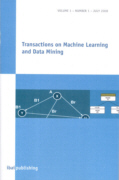 |
International Workshop Case-Based Reasoning on Multimedia Data
CBR-MD 2009
July 22, 2009, Leipzig/Germany
Workshop Chair
Petra Perner, Institute of Computer Vision and applied Computer Sciences, IBaI, Germany
Linda Shapiro, University of Washington, USA
Organisational Chair
Sylvia Schmiedel, Institute of Computer Vision and applied Computer Sciences, IBaI, Germany
Program Committee
- Isabelle Bichindaritz, University of Washington, USA
- Bernadette Bouchon-Meunier, UPMC - LIP6, France
- Enis Cetin, Bilkent University, Turkey
- Peter Funk, Malardalen University, Sweden
- Dimitris Karras, Chalkis Institute of Technology, Greece
- Fei-Fei Li, Princeton Vision Lab, USA
- Ramon Lopez de Mantaras, Artificial Intelligence Research Institute (IIIA), Spain
- Erkki Oja, Helsinki University of Technology, Finland
- David Patterson, University of Ulster, Northern Ireland
- Ashwin Ram, Georgia Institute of Technology, USA
- Michael Richter, University of Calgary, Canada
- Ovidio Salvetti, National Research Council, Italy
- Rainer Schmidt, University of Rostock, Germany
- David Wilson, University of North Carolina, USA
- Xingquan Zhu, Florida Atlantic University, USA
Scope of the Workshop
Multimedia systems are becoming increasingly popular in medical, industrial, ecological, biotechnological and many other application domains. Multimedia data includes signals of 1-dimensional, 2-dimensional or 3-dimensional nature, video, audio, text, trajectories, and data streams. Existing statistical and knowledge-based techniques to analyse and interpret these signals lack robustness, accuracy and flexibility. New strategies are needed that can adapt to changing environmental conditions, signal variation, user needs and process requirements. Applying Case-Based Reasoning (CBR) strategies in multimedia data interpreting systems can help satisfy these requirements. CBR can be used to control signal processing in all phases of an interpreting system to derive information of the highest possible quality. Beyond this, CBR supports different learning capabilities throughout the signal interpretation process that satisfy different needs during the development phase of the system. The unique data and the necessary computation techniques require extraordinary case representations, similarity measures and case-based reasoning strategies to be utilised. This workshop should provide a forum for discussion of the specific topics related to CBR on multimedia data.
For more information about Case-Based Reasoning for Multimedia Data please see:
Image Processing in Case-Based Reasoning,
P. Perner, Alec Holt, Michael Richter
The Knowledge Engineering Review, Vol. 20:3, 311-314
P. Perner (Ed.), Case-Based Reasoning on Signals and Images, Springer Verlag, 2007
For general information on CBR see the special issue:
CBR Commentaries: The Knowledge Engineering Review, Vol. 20
The goals of this workshop are to:
- provide a forum for identifying important contributions and opportunities for research on case-based reasoning as it applies to multimedia data
- promote the systematic study of how to apply case-based reasoning to images, signals, video, audio, trajectories and data streams
- show case applications of case-based reasoning on multimedia data.
Topics of interest include (but are not limited to):
- CBR for signals, images, video, audio and text
- Similarity assessment for signals, images, video, audio, and text
- Case representation and case mining for multimedia data
- Retrieval and indexing of signals, images, video, audio and text
- Conversational CBR for multimedia retrieval systems
- Meta-learning for model improvement and parameter setting for processing with CBR
- Incremental model improvement by CBR
- Case base maintenance for systems with multimedia data
- Case authoring
- Life-time of a CBR system
- Measuring coverage of case bases
- Analogical reasoning for computer vision, signal processing and others
- CBR in robot navigation
- CBR for medical applications using multimedia data
- CBR for biotechnological applications using multimedia data
- CBR for chemical applications using multimedia data
- Ontology learning with CBR
- CBR for image processing applications
- CBR for video applications
Submission Requirements
All papers will be published in the Workshop Proceedings by IBaI publishing. Post-Proceedings with extended versions of the papers will be published in the Studies in Computational Intelligence by Springer Verlag after the workshop. Selected papers will be published after revision in a special issue in the Journal Pattern Recognition Letters.
Paper submissions should be formatted according to Springer LNCS format, with a maximum of 15 pages.
Author's instructions along with LaTeX and Word macro files are available on the web at
http://www.springer.de/comp/lncs/authors.html.
Please e-mail your submission as doc-file and pdf file to cbr@data-mining-forum.de.
Important Dates
Submission Deadline: May 5th, 2009
Notification Date: May 31st, 2009
Camera-Ready Deadline: June 10th, 2009
Workshop date: July 22nd, 2009
|
 |





